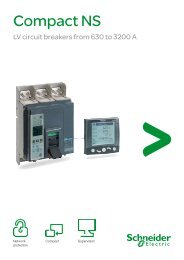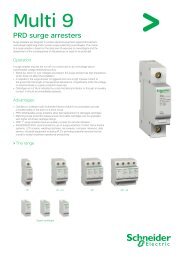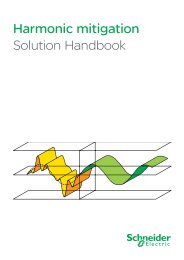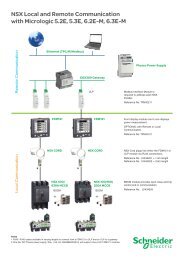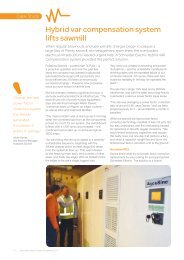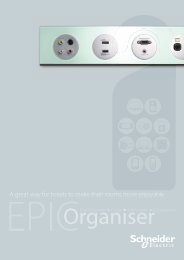Schneider Electric Schneider Electric
Schneider Electric Schneider Electric
Schneider Electric Schneider Electric
- No tags were found...
Create successful ePaper yourself
Turn your PDF publications into a flip-book with our unique Google optimized e-Paper software.
configuration comprising two parts: a 300-amp<br />
Accusine PCS harmonic filtering and reactive<br />
power compensation system, supported by a<br />
static bank of capacitors (600kVar).<br />
“We could have opted for a bigger Accusine<br />
PCS unit and eliminated the static bank entirely,”<br />
says Davies, “but for us a smaller unit with the<br />
complementary static bank was a more costeffective<br />
option. It works perfectly, with the static<br />
bank correcting for the base load and lifting the<br />
power factor correction to a certain level.<br />
“The Accusine takes over from there, catering<br />
for the more variable fluctuations. The advantage<br />
of the Accusine is its speed – it performs the<br />
correction in milliseconds. The static bank unit<br />
is too slow, but it doesn’t have to deal with the<br />
fluctuations.”<br />
The site now operates with a power factor<br />
correction ratio of 0.97 – and the penalty charges<br />
have disappeared.<br />
The most interesting part of the power factor<br />
solution, says Davies, is that the load on the<br />
transformer has been reduced. “That not only<br />
translates into better overall reliability because<br />
there’s less heat in the cables, but it’s also given<br />
us scope to expand and adapt the site to market<br />
developments.”<br />
In fact, the sawmill has subsequently installed<br />
a new kerf saw – it now represents the biggest<br />
single load at the site – which allows crews to<br />
process and optimise second-grade timber more<br />
easily. “Overall, the new power factor correction<br />
system has already generated thousands of<br />
dollars in savings.”<br />
Harmonics<br />
So far, rogue harmonics haven’t been a problem<br />
at the sawmill, but Davies is well aware that they<br />
might become an issue as new technology is<br />
introduced. “A significant advantage of having<br />
the Accusine unit installed is that it also operates<br />
as a harmonic filter. If harmonics did become a<br />
problem, we would simply activate the Accusine’s<br />
existing filter component.”<br />
He says monitoring the site’s electrical load is<br />
now simple thanks to the feedback provided by<br />
the Accusine system. “The unit’s multi-functional<br />
display provides good data, and I’m hoping to<br />
install a SCADA system at some point to generate<br />
monitoring, trending information and alarms more<br />
easily.”<br />
Project at a glance<br />
Project type:<br />
Low Voltage Power Compensation<br />
and Filtering<br />
Location:<br />
Pukepine Sawmills Ltd., Tauranga,<br />
New Zealand<br />
Applications:<br />
Hybrid VAR Compensation System<br />
Main Products<br />
> Accusine PCS<br />
> Varset power factor correction units<br />
<strong>Schneider</strong> <strong>Electric</strong> News December 2012 11




